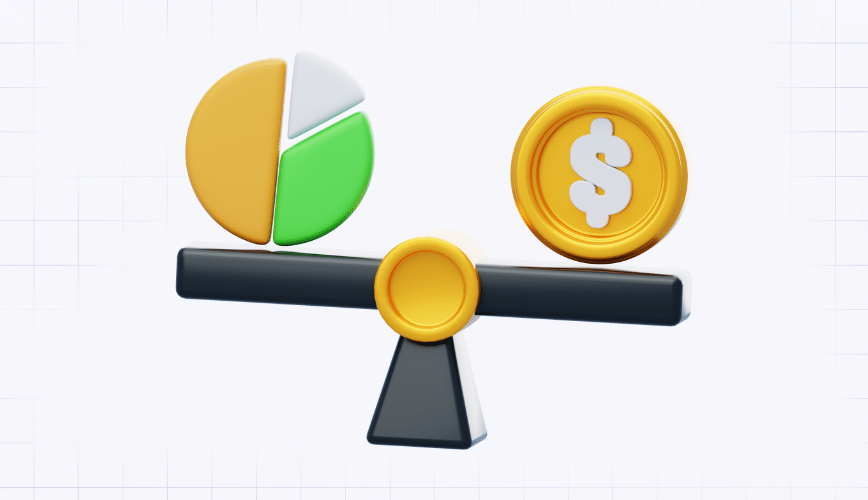Key performance indicators (KPIs) help evaluate a category manager’s performance. The measurement of a category manager’s work should be based on the analysis of these indicators, which should be accessible, measurable, and delineated in terms of time. This ensures the objectivity and transparency of the motivation system, which is crucial when a category manager’s salary consists of a base salary and bonuses.
There are many KPIs for category managers, and each company chooses its own to form its motivation system. In this article, we will highlight the most common basic KPIs.
Contents
The Main KPIs of a Category Manager
How to Set KPIs for a Category Manager and Ignite Sales
Category Management Dashboards For Market Monitoring
The Main KPIs of a Category Manager
1. Category Turnover
What is this?
Category turnover is a key performance indicator that reflects the dynamics of category sales and is characterized by the amount of money earned over a certain period of time, such as a month, quarter, or year.
How is it calculated?
To calculate turnover, there are two formulas: one is based on the price of a unit of goods and the quantity sold per month, and another is based on daily revenue.
Turnover per month = price of a unit of product at which they are sold × quantity of products that is planned to be sold per month.
Turnover = the amount of revenue for the first day + the amount of revenue for the second day + … + the amount of revenue for the last day of the period.
It is important to monitor the trend of turnover, as this indicator reflects the changes in sales over time.
The calculation for turnover dynamics is:
Turnover for the period ÷ turnover for the previous period x 100%.
Similarly, you can calculate the dynamics for a quarter or a year.
It’s important to prescribe a sales plan in advance and compare it with the results obtained to identify areas for improvement and take appropriate action.
How to analyze?
You need to track the following:
- the actual value of turnover;
- its dynamics as a percentage;
- the ratio of the plan to the fact (percentage of the plan achieved for the turnover).
25 KPIs That Every Category Manager Should Know
Unlock the essential checklist for Category Managers: Dive into key KPIs, their definitions, and calculation formulas now!
2. Profit by Category
What is this?
It’s simple: the main indicator for a category manager is gross profit since other types of profit are influenced by other departments. The higher the number, the better:-) For a category manager, the gross profit per category will indicate the optimal assortment, well-chosen suppliers, and pricing policy.
How is it calculated?
Gross profit for a certain period = revenue for a certain period — the cost of goods.
How to analyze?
To analyze this indicator, track the following:
- actual profit figures;
- absolute and percentage changes in profit over time;
- plan-to-actual ratios (i.e. the percentage of the planned profit that was actually achieved).
3. Margin
What is this?
Gross margin is the profit you make from the selling price of a particular product, expressed as a percentage.
How is it calculated?
This is done by subtracting the cost price from the selling price and dividing the result by the selling price, then multiplying by 100 to get a percentage:
Gross margin (%) = (selling price — cost price) ÷ selling price × 100.
For example, if you bought a product for 4,000 EUR and sold it for 10,000 EUR, the gross margin would be:
Gross margin = (10,000 EUR – 4,000 EUR) ÷ 10,000 EUR × 100 = 60%.
How to analyze?
To analyze gross margin, track the following:
- actual margin value as a percentage;
- margin dynamics over time;
- plan-to-actual ratio (i.e. the percentage of the planned margin that was actually achieved).
4. GMROI
What is this?
GMROI (Gross Margin Return on Inventory Investment) is the gross profit on inventory investment. It is one of the best tools for measuring and managing the performance of your inventory investment. GMROI measures how much a company earns for each dollar invested in purchasing a product. For example, if GMROI = 30 EUR, this means that for each hryvnia invested in a product, the profit is 30 EUR.
GMROI measures how efficiently a company buys and sells its products.
How is it calculated?
GMROI = gross margin for the period ÷ average cost of inventory for the same period.
For example, if you sell products for 100,000 EUR per year with a gross margin of 45%, and the average inventory at cost is 35,000 EUR, the gross profit would be:
Gross profit (EUR) = 100,000 × 0.45 = 45,000 EUR
GMROI = 45,000 EUR ÷ 35,000 EUR = 1.285.
This means that for every 1 EUR you invest in a product, you earn 1.285 EUR.
How to analyze?
To analyze GMROI, you need to track:
- GMROI;
- dynamics of GMROI;
- plan-to-actual ratio (i.e. the percentage of the planned GMROI that was actually achieved).
The return on inventory will show how well the assortment is formed and whether the inventory is sufficient to generate profit. A positive indicator of the work of a category manager is the growth of this indicator.
5. Inventory Turnover
What is this?
The inventory turnover ratio measures how many times a company sells and replaces its inventory within a given period of time. It gives an indication of how effectively the category manager is managing the inventory.
How is it calculated?
Inventory turnover = cost of goods sold for a certain period ÷ average inventory for the same period.
Note: When calculating inventory turnover, use the cost of goods sold in the formula instead of the cost of sales to avoid a misleading result. The average inventory is taken at cost, not retail value.
Cost of goods sold = opening stock + purchases — ending stock.
Opening and ending stocks can be taken from the balance for the previous and current periods (at cost!).
Average stock = (initial stock (EUR) + ending stock (EUR)) ÷ 2.
Alternatively, you can compute average stock as the total of inventory at the end of each month divided by 12.
Average stock = (January + February + March + April + May + June + July + August + September + October + November + December) ÷ 12.
How to analyze?
You need to track:
- inventory turnover ratio;
- plan/fact ratio (percentage of the plan in terms of turnover).
It’s important to note that inventory turnover ratios vary across different categories. For instance, goods in online pharmacies turn around more frequently than in online electronics stores. Therefore, when analyzing your figure, make sure to compare it with the category your business belongs to. Here is a list of inventory turnover ratios in different categories:
- clothes — 3.25;
- supermarkets — 3.72;
- pharmacies — 12.55;
- cosmetics — 2.5;
- household appliances and electronics — 6.93.
Source: https://www.retaildogma.com/retail-benchmarks
6. Product Availability
What is this?
Another crucial KPI for category managers is product availability, which enables them to determine how many products from the current assortment matrix are in stock and available for customers to order.
How is it calculated?
Availability (%) = number of products (SKUs) with the status “In stock” ÷ number of products (SKUs) in the entire category × 100%.
How to analyze?
The following should be tracked:
- availability (as a percentage);
- changes in availability dynamics;
- plan/actual ratio (percentage of plan completion by availability).
It’s essential to provide the warehouse with products that are “category drivers.” These products can be selected based on turnover, profit, margin, and analyzed using ABC/XYZ analysis.
In Pricer24, you can easily compare the availability of products in competitors’ stores by categories, groups, segments, or individual items. After conducting an ABC/XYZ analysis, you can label specific SKUs as “A,” “B,” or “C” and track the availability of critical items on the dashboard with a single click.
How to Set KPIs for a Category Manager and Ignite Sales
Before implementing KPIs for a category manager, it is important to take the following steps:
- Define and align the KPI plan with the company’s goals and document them for the team.
- Create a plan with benchmarks and set up a schedule for reviewing results.
- Foster team interest in measuring performance by ensuring that each category manager understands how KPIs are calculated and how achieving them affects remuneration. The motivational system should be transparent and clear.
Ensure that each employee has the technical ability to quickly obtain information about the status of indicators to help them stay focused. Analytics tools with regular reports and dashboards can also be useful.
Category Management Dashboards For Market Monitoring
For daily market monitoring, we offer our retail clients 3 key category manager dashboards:
1. Competitor Price Analysis Dashboard
2. Competitor Assortment Analysis Dashboard
3. Market Analysis Dashboard
I want these dashboards. How can I get them?
- If you are not yet a Pricer24 client, fill out the contact form at the bottom or top of this page and our manager will get in touch with you.
- If you are already our client, our support team will help you configure the reports and display them on your dashboards.
- If you are already an experienced Pricer24 user, you can learn more about each dashboard through the links above and create similar dashboards of your own.
Conclusion
Key performance indicators (KPIs) provide the category manager with a holistic view of each category’s performance. Therefore, implementing and tracking them is necessary to help the entire category department align their efforts with the online store’s main business goals.
Use modern business solutions for collecting and visualizing market data to keep your finger on the pulse and be ready to adjust your KPIs and strategies as needed.









